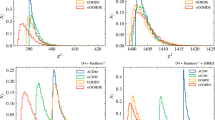Abstract
We show that, on the average, a homogeneous and isotropic scalar field and, on the average, homogeneous and isotropic ensembles of classical and quantum gravitational waves generate the de Sitter expansion of empty (with no matter) space-time. At the start and by the end of its cosmological evolution, the Universe is empty. The contemporary Universe is about 70% empty, so the effect of cosmological acceleration should be very noticeable. One can assume that itmanifests itself as dark energy. At the start of the cosmological evolution, before the firstmatter was born, the Universe was also empty. The cosmological acceleration of such empty space-time can manifests itself as inflation. To get the de Sitter accelerated expansion of empty space-time under influence of scalar fields and classical and quantum gravitational waves, one needs to make a mandatory Wick rotation, i.e., one needs to make a transition to Euclidean space of imaginary time. One can assume that the very existence of inflation and dark energy could be considered as a possible observable evidence for the fact that time by its nature could be a complex value which manifests itself precisely at the start and by the end of the evolution of the Universe, i.e., in those periods when the Universe is empty (or nearly empty).
Similar content being viewed by others
References
A. Guth, Phys. Rev. D 23, 347 (1981).
A. D. Linde, Phys. Lett. B 108, 389 (1982).
A. Albrecht and P. Steinhardt, Phys. Rev. Lett 48, 1220 (1982).
A. G. Riess et al., Astron. J. 116, 1009 (1998).
S. Perlmutter et al., Ap. J. 517, 565 (1999).
S. Weinberg, Cosmology (Oxford Univ. Press, 2008).
P. Ratra and L. Peebles, Phys. Rev. D 37, 340 (1988); P. Ratra and L. Peebles, Rev. Mod. Phys. 75, 559 (2003).
R. Caldwell, R. Dave, and P. J. Steinhardt, Phys. Rev. Lett. 80, 1582 (1998).
L. Marochnik and D. Usikov, Grav. Cosmol. 21, 118 (2015).
L. Marochnik, D. Usikov, and G. Vereshkov, Found. Phys. 38, 546 (2008).
L. Marochnik, Grav. Cosmol. 22, 10 (2016).
E. Kolb and M. Turner, The Early Universe (Frontiers in Physics, Addison-Wesley, 1990).
A. Guth, in Pritzker Symposium on the Status of Inflationary Cosmology, 1999; astro-ph/0002188.
A. Linde, J. Phys. Conf. Ser. 24, 151 (2005).
A. Linde, New Astronomy Reviews 49, 35 (2005).
A. Linde, Phys. Lett. B 129, 177 (1983).
T. S. Bunch and P. C. W. Davies, Proc. R. Soc. London A 360, 117 (1978).
A. Starobinsky, Pis’ma JETP 30, 719 (1979); JETP Lett. 30, 682 (1980).
L. R. W. Abramo, R. Brandenberger, and V. Mukhanov, Phys. Rev. D 56, 3248 (1997).
A. Ishibashi and R. Wald, Class. Quantum Grav. 23, 235 (2006).
L. Marochnik, D. Usikov, and G. Vereshkov, J. Math. Phys. 4, 48 (2013); arXiv: 0811.4484.
L. Marochnik, Grav. Cosmol. 19, 178 (2013); arXiv: 1306.6172.
R. Rajaraman, Solitons and Instantons. An Introduction to Solitons and Instantons in Quantum Field Theory (North Holland, Amsterdam, 1982).
M. A. Shifman, Ed., Instantons in Gauge Theories (World Scientific, Singapore, 1994).
N. N. Bogolyubov, A. A. Logunov, A. I. Oksak, and I. T. Todorov, General Principles of Quantum Field Theory (Kluwer, Springer, 1990).
G. W. Gibbons and S. W. Hawking, Eds., Euclidean Quantum Gravity (World Scientific, Singapore, 1993).
V. A. Rubakov and P. G. Tinyakov, Phys. Lett. B 214, 334 (1988).
G. Esposito, Int. J. Geom. Meth. Mod. Phys. 2, 675 (2005); arXiv: hep-th/0504089.
B. J. Hartle and S. W. Hawking, Phys. Rev. D 28, 2960 (1983).
S. W. Hawking, The Universe in a Nutshell (Bantam Books, 2001).
Author information
Authors and Affiliations
Corresponding author
Rights and permissions
About this article
Cite this article
Marochnik, L. Cosmological acceleration from a scalar field and classical and quantum gravitational waves (Inflation and dark energy). Gravit. Cosmol. 23, 201–207 (2017). https://doi.org/10.1134/S0202289317030082
Received:
Published:
Issue Date:
DOI: https://doi.org/10.1134/S0202289317030082




